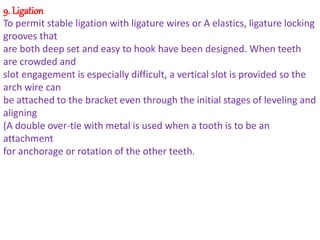lingual ort.pptx
- 1. Lingual orthodontic By Dr .ZAID. AlDEWACHI, MSC, ORTHODONTIC, high speciality in lingual orthodontic µ implant
- 2. Main purpose of orthodontic treatment; 1.Esthetic 2. function. 3,. Stability. .4 Good oral health. .4 . Kinya Fujita introduced lingual appliance system
- 7. Development of Fujita Actual research :1971 Edgewise &Begg:1975 Lingual bracket:1976 First case reported:1978
- 8. Slot types &size of lingual bracket Fujita: occlusal (0.020&0.019)sequre wire Lingual (0.018 edgewise wire &0.028round wire Vertical slot:0.016 sequre wire Ormco: lingual slot 0.018,0.022 edge wise wire 0.016sequre wire Unitek: occlusal slot only : Dentaurum occlusal (0.020 sequre wire Vertical 0.016
- 10. Uses of slot 1.Occlusal slot: easy of insertion and removal of the wires. 2.Horizontal slot: easy of correct the vertical movement in addition to the correction of the torque and angulation. 3.Vertical slot: useful to the use of various auxillaries.
- 12. the development of lingual orthodontic therapy and the current solutions:
- 13. Why it is difficult? 1.Shear of bracket. 2.Arch wire ligation. 3.Deep bite. 4.Precise bracket positioning. 5.Precise wire bending. 6.Treatment quality. 7.Anchorage control. 8.Poor posture during treatment.
- 15. 1. Tissue Irritation and Speech Difficulties The earlier brackets placed on the lingual surface of the teeth were irritating to the tongue and impeded normal speech. The current generation of brackets has been Initially, anterior brackets had long gingival hooks responsible for calculus build-up. 10 LINGUAL ORTHODONTICS redesigned with smooth exterior surfaces and a low profile. The increased comfort allows normal tongue activity, hence speech is not affected significantly. 2. Gingival Impingement Earlier generations of the lingual appliance had a broad bonding base extending towards the gingival margin . Access for adequate oral hygiene and the self-cleansing nature of the oral cavity were compromised. Brackets have been redesigned to be more self-cleansing. The base now extends incisally and mesiodistally, providing adequate bond strength, yet retaining hygienic qualities. The mandibular anterior teeth are particularly vulnerable to calculus accumulation due to their close proximity to the submandibular salivary glands. These brackets have 1.5 to 2 mm clearance between the base and the gingival margin. Additionally, the bracket hooks have been redesigned with a lower profile and are located several millimeters from the gingival margin .
- 17. 3. Occlusal Interference A predominant problem with the original appliance was the effect of the shearing forces on the brackets, particularly in the maxillary anterior dentition. (In the absence of a cross-bite, the lingual aspect of the mandibular dentition is generally not in direct contact with the maxillary dentition; therefore, the shearing forces were not a problem (Likewise, the relatively high maxillary crown height and low mandibular cusp height in the posterior segments allow adequate clearance to avoid the severe shearing forces seen in the maxillary anterior region.) The bracket was redesigned with an inclined or bite plane strategically placed to redirect the vertical shearing forces to a horizontal seating force . The location of the inclined plane is such that when a 1 mm over jet and overbite relationship is obtained, all mandibular anterior contact with the inclined plane is eliminated. To avoid these effects caused by tooth contact with the arch wire, the inclined plane is located incisal to the slot. .
- 20. 9. Ligation To permit stable ligation with ligature wires or A elastics, ligature locking grooves that are both deep set and easy to hook have been designed. When teeth are crowded and slot engagement is especially difficult, a vertical slot is provided so the arch wire can be attached to the bracket even through the initial stages of leveling and aligning (A double over-tie with metal is used when a tooth is to be an attachment for anchorage or rotation of the other teeth.
- 21. Appliance Placement and Bonding The original appliances were direct bonded. With the variability of lingual tooth contours, accurate bracket placement was difficult. This approach produced unpredictable tooth alignment with tremendous variations in tip, torque, and tooth height. Initially, the Torque Angulation Referencing Guide (TARG) system was used. The TARG instrument was designed to place brackets on the lingual surfaces using conventional landmarks as references. Although substantial improvements were made in the accuracy and efficiency of bonding, the system was still inadequate. A more sophisticated system, using a diagnostic set-up constructed from articulated models was developed and has met with considerable success. This method, the Custom Lingual Appliance Set-Up Service (CLASS), involves indirect bonding set-up on a diagnostic or ideal model of the teeth. The brackets are then transferred back to the original malocclusion, and transfer trays prepared..
- 23. Why precise bracket positioning;;;;;; . 1.Less arch wire bending . 2.Less chair time . 3.Less treatment time. 4. Better treatment quality. 5.Reducing relapse. Considering factors in bracket positioning. 1.Vertical height. 2.Horizontal rotation. 3.Axial angulation. 4.Torque inclination
- 34. The American Lingual Orthodontic Association (ALOA) was established on November 14, 1987, by a core group of six hundred American orthodontists. Membership quickly grew to over 800 members in 17 countries. The ALOA provided quarterly journals, study club assistance, patient brochures, yearly conventions, and professional lectures. The first annual meeting of ALOA was held in Washington in 1987, and in Palm Springs the following year. Japanese university programs offered training in lingual therapy and these were soon followed by courses in Korea, South America, Mexico, and Denmark. The European Society of Lingual Orthodontics (ESLO) was founded in 1992, in Venice, Italy, and hundreds of people participated in the first European lingual association
- 35. Center of rotation of palatal root




































